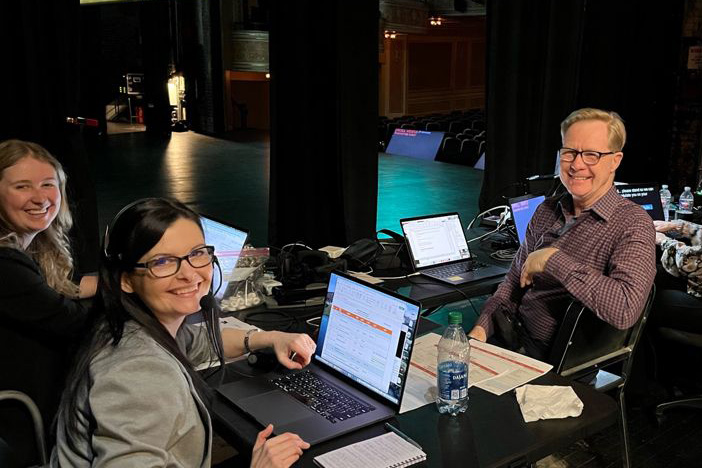Understanding How to Organize a Successful Hybrid Event
Hybrid events grew drastically toward the end of the pandemic, allowing for more participation and the ability to expand your event’s reach to an international level.
Successful hybrid event planning begins with identifying your experiential objectives and clearly determining the event experience you want both in-person and virtual attendees to have. It is also important to make sure your virtual platform aligns with your goals and attendee experience.
This article will guide you through some essential steps for planning hybrid events, but you should still seek guidance from an experienced event production company. Advice from a knowledgeable professional and access to their specialized technology will help you plan your hybrid event, making it easier to connect your people and grow your business.
Define Your Event Goals and Objectives
The first step in hybrid event planning is establishing clear, obtainable goals, such as audience engagement and brand awareness. Setting measurable objectives is crucial for gauging the hybrid event’s effectiveness.
Considering Key Performance Indicators
Key performance indicators (KPIs) for hybrid event planning take on many shapes and forms, but similar to any live event, should be intentionally aligned with your overall business objectives.
It’s important to note that in-person and virtual attendees will have distinct experiences, and you should design KPIs for each. Some examples of KPIs for in-person attendees include:
- Attrition rate
- Session attendance
- Exhibit booth traffic
- Event app downloads
On the other hand, some examples of KPIs for virtual attendees are:
- Login rate
- Viewing time
- Reported technical issues
- Number of content downloads
- Q&A, chat, and polling interactions
Some KPIs, like survey-provided feedback and ratings, will apply to your hybrid event’s virtual and in-person components.
Choose the Right Platform
Before fleshing out the other details in your hybrid event planning process, you should pick a virtual event platform with features that align with your event goals. Many platforms offer a basic suite of features, which include:
- Live chat, Q&A, polling
- Gamification and leaderboards
- Interactive floorplans
- Easily branded landing pages
- Enhanced virtual networking
- Sponsorship management
- Accessibility offerings like closed captioning or translation services
When choosing between video platform options, you should compare their tools, scalability, security, reliability, and pricing. Some online platforms only support a limited number of users, while others may be vulnerable to crashes or security breaches. Seeking advice from experienced event planners can help you weigh available platforms and select one that meets your unique needs.
Select a Suitable Venue
Choosing where you want to host the in-person component of your hybrid event is just as important as selecting the virtual platform. You should consider the following elements while researching potential in-person sites.
Technical Infrastructure
Just about any live event venue can be designed for an in-person audience, but other variables become important factors when streaming to a virtual audience. Ensure the venue provides reliable, high-speed internet with enough bandwidth to support live streaming and other features offered by your virtual platform. If not, you will need to consider bringing in onsite bonded cellular for additional bandwidth, or as a backup.
Audio and lighting are equally critical for both audiences, especially your virtual viewers. It’s important to intentionally design your production environment to make sure your presenters and audience alike are set up for success. This includes well-lit, properly framed presenters for the camera who can be heard clearly on the screen.
Accessibility
Accessibility is important for hybrid events, and while most venues offer ADA-compliant infrastructure for in-person attendees, you also need to offer content for all abilities at your event for both audiences. This includes American Sign Language (ASL) interpreters and closed-captioning, which can be done with live captioners or AI translation. Accessibility also includes language translation on your virtual event site for international audiences.
Outline the Event Structure and Content
Crafting a balanced agenda will ensure that your content appeals to onsite and online audiences. Remember: same event, two very different experiences. So, think about how to plan white space in the agenda for both groups.
You should also consider how virtual attendees will interact with one another during networking functions, such as virtual breakout rooms. Providing equal opportunities for both groups to interact with content is best. For example, allow remote attendees to answer polls and live chats from their computers while in-person guests use your event app to participate in the same offerings.
When building out your hybrid event’s schedule, consider time zones and their effect on accessibility for remote participants, especially if you’re planning for international attendees. Taking steps like recording event segments and making them available for on-demand viewing later will increase accessibility.
Coordinate Logistics for Both In-Person and Virtual Components
As recently as 2021, approximately 50% of business-to-business marketers stated that simultaneously balancing hybrid events’ physical and digital experiences was a major obstacle. Practicing the following tips will help you coordinate the logistics between your event’s in-person and virtual components.
Invest in the Right Platform
As stated above, many platforms offer comparable features, but to go deeper into another layer, think about your virtual audience and what they want to see from an online experience. Many virtual event platforms have consolidated in recent years, and many integrate into your overall event management software. Are you simply sending a feed from your live sessions to an existing website or intranet? Or are you looking for a highly interactive experience with digitally branded rooms and user-generated avatars? This is where form and function both play a role.
Perform Pre-Event Rehearsals
This step can’t be stressed enough: all equipment, bandwidth, and streaming platforms must be tested with each presenter. If you have virtual presenters, their internet speed and equipment must also be tested. Join a pre-event livestream from several devices and locations to verify that the streaming software integrates seamlessly with your hardware and online safety protocols, including making sure your platform complies with your existing firewall.
This is also the appropriate time to make sure all presenters are seen and heard well by your virtual attendees (and, of course, those in the room).
Have Technical Support Available
Although pre-event rehearsals can help you weed out some technical issues, complications may still arise on the event day. So, provide technical support for virtual components live during sessions. Onsite support can troubleshoot problems related to hardware and connectivity, while the virtual support team can assist remote attendees with connectivity and access concerns.
Provide clear instructions on contacting support and ensure that support staff are properly trained to handle common issues efficiently. Setting up help desks and support channels is an excellent way for attendees to seek assistance quickly.
Calibrate Your Attendees’ Expectations
Before the event, educate attendees on the hybrid format. Include guides and tutorials describing how to use the virtual platform, including how to join sessions and participate in interactions. You can also use information packets to communicate event details to attendees, providing them with support contacts, basic troubleshooting tips, and answers to frequently asked questions. Some people may also benefit from scheduled reminders informing them of any time changes or additional information.
Prepare Keynote Speakers
Many keynote speakers today are adept at presenting virtually and talking to remote audiences who are not in the room. Some tips for choosing a fitting keynote speaker for a hybrid event are:
- Engagement skills – You should search for dynamic speakers who can captivate physical and virtual audiences.
- Hybrid experience – If possible, select speakers with experience participating in hybrid or virtual events to ensure their comfort and minimize training.
- Technical competence – Ensure the speakers you choose are comfortable with the technology you are using and can handle basic technical issues.
Measure Success and Gather Feedback
What happens after the event is as important as what happens during. Some practices you should implement after each hybrid event are:
- Distribute quick exit surveys to both in-person and virtual attendees
- Review the event’s KPIs and rate their success
- Take notes on what you learned
- Brainstorm ways to augment future events
When seeking feedback from attendees, include quantitative rating scales and qualitative open-ended questions. Doing so will help you approach future hybrid events in a way that encourages growth and more success.
An event production agency will provide guidance on utilizing analytic tools to track engagement and attendance. Event professionals can help you evaluate KPIs in a way that clearly illustrates the event’s turnout and participation levels for both in-person and online components.
Download Our eBook: 8 Fundamentals of an Internal Communications Strategy
If your people are sending out the “whatever” vibes, it’s time to get back to the basics. Make sure your internal communication strategy is following 8 fundamentals to cultivate an engaged workforce aligned with your company’s success.
Make Sure Your Hybrid Event Planning Pays Off
Knowing how to plan a hybrid event with a high chance of success is difficult without assistance from a highly qualified event production agency. Hybrid event planning requires setting pragmatic goals, creating a reliable outline of activities that fits your budget, and choosing the right places to offer your event’s in-person and online elements.
Although the information from this article will provide a reliable path for hybrid event planning, it is not an exhaustive list of implementable strategies. The talented event planning professionals at CPG will know precisely how to plan your hybrid event. We offer virtual and hybrid event production services with individualized, data-backed strategies that will work for your unique goals and target audience. Altogether, this targeted approach helps to increase your event’s impact and maximize your ROI.
Contact CPG for expert-level event planning services that will leave a lasting impact on your attendees.


